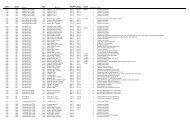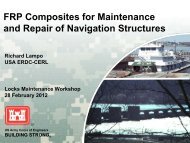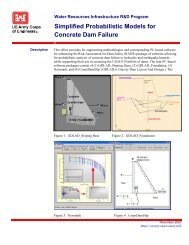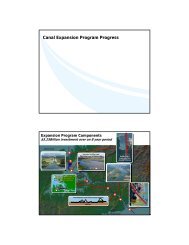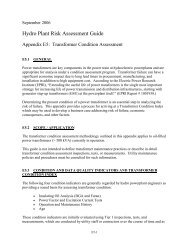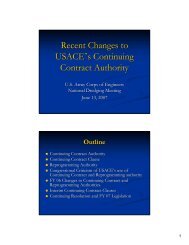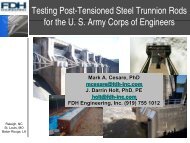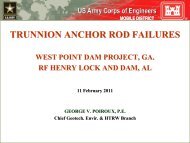Hydro Plant Risk Assessment Guide
Hydro Plant Risk Assessment Guide
Hydro Plant Risk Assessment Guide
Create successful ePaper yourself
Turn your PDF publications into a flip-book with our unique Google optimized e-Paper software.
Table 12 – Yielding, Fracture, Fatigue, and Fabrication Discontinuities<br />
Results<br />
Good – No visible yielding or buckling, there is little to no cracking<br />
near welds and/or stress concentrators. Any cracks have not<br />
propagated significantly.<br />
Moderate – May be slight yielding; cracking near stress<br />
concentrators or welds is intermittent with little or no propagation.<br />
Can justify the use of non-destructive testing on some welds.<br />
Severe – Significant yielding or buckling in critical members,<br />
cracking in a sequence of welds, crack propagation in many cracks.<br />
Usually justifies the use of non-destructive testing on most welds.<br />
Adjustment to<br />
Condition Index Score<br />
Add 1.0<br />
No Change<br />
Subtract 1.0<br />
Test T2.1.3: Gates – Improper Field Repair and/or Modifications<br />
Gates that have been significantly modified in the field without proper engineering and quality<br />
control may be structurally compromised. Improper repairs include, but are not limited to:<br />
• Replacing parts with lesser quality or strength parts than the gate was engineered for<br />
(bolts, skin plates, picking eyes, structural steel, etc.)<br />
• Protective coatings that are improperly formulated or applied<br />
• Cutting of beam webs or flanges<br />
• Improper welding/rewelding<br />
Table 13 – Improper Field Repair and/or Modifications<br />
Adjustment to<br />
Results<br />
Condition Index Score<br />
Good – No field repairs or modifications done without proper<br />
engineering analysis.<br />
No Change<br />
Moderate – Some minor repairs, not likely to cause failure. Subtract 0.5<br />
Severe – Major modifications that severely compromise the<br />
structural integrity of the gate.<br />
Subtract 1.0<br />
Gates – Functional Operation<br />
Test T2.1.4: Gates – Raising/Lowering Performance<br />
This evaluation criterion is based on the overall performance of the emergency closure system.<br />
The gate should lower and raise in a certain amount of time as specified by organizational<br />
standards. Performance tests should be implemented where reasonable. This section is<br />
concerned if the gate binds or hangs up in the gate slot due to dimensional alignment<br />
deficiencies, not the gate operator itself.<br />
E11-16



